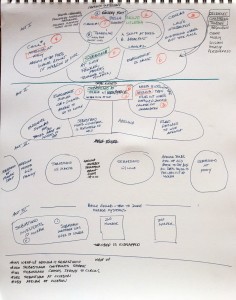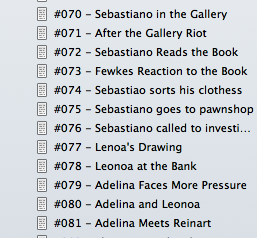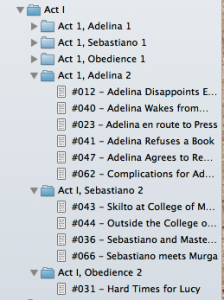
Overall
Writing is a skill – like any other skill, you get better and more efficient at it. Successful writers write steadily. Don’t worry about speed. Think of every word written down as one closer to your goal.
Writing is also a cyclical process. Ideas are generated and get fed back in. Don’t sweat the messiness as this process is underway because readers will never see anything but the final results. No first draft will be perfect.
Day One
Describe one character with 5-7 single sentences that each describe him/her/it in a specific area, such as their love life, education, current situation, occupation, hobbies, problems, etc.
Day Two
For each of your sentences, write two more sentences that each on it, creating a paragraph about each area of description.
Day Three
Write a single sentence about each life area that runs counter to the previous sentiment. For example, a paragraph about how the character really wants children might have a sentence about how they’re sterile. A paragraph about how they’re happily married might merit a sentence about feeling attracted to the new office manager at work.
Day Four
Write two more sentences expanding on each of the negative sentences from the previous day. You should end up with five (Michael said overachievers can go as high as seven) life areas with two paragraphs describing each. The discrepancy between the two paragraphs creates conflict, which is needed to create story.
Day Five
Repeat Days 1-4 for a second character, who doesn’t have to be involved with the first. They should be characters that interact in a story but are not protagonist and antagonist.
Day Six
For each character, think about short and long term life goals. Write down two short and one long for the character. Bonus points if some goals conflict. This part provides insight plus other stuff for the character to do.
Day Seven
Look at both characters and chart out the obstacles and fears in their life that keeps them from attaining their goals. These are problems you will have to engineer a way past.
Day Eight
Repeat steps 1-4, 6, & 7 for a third character. This lets you think about the characters in terms of a triad, rather than a pair. Interactions between pairs are predictable and low energy, so the new possibilities created by a third character help keep a story high energy.
Day Nine
This day’s devoted to developing a character’s voice. You want each character to have a unique voice. The more you know about a character, the easier it is to write, because some decisions have been made already. Write a letter (no minimum or maximum length) from one character to another doing one of the following: a) asking for help, b) warning them about something, c) apologizing, or 4) explaining something. The text of the note should demonstrate vulnerability on the part of the character writing it. Once it’s written, think about the physical appearance it will take when delivered to another character, which will provide additional insight.
Day Ten
Write a scene consisting of dialogue only (with no attributions) which is a conversation between the letter writer and its recipient. Because there are no attributions, you will need to make sure each character’s voice is differentiated enough that you can tell who’s speaking. Ways to do so: establish level of education, use jargon from their background or job, use verbal tics, etc. Make as long as appropriate, but should prbably be at least a page.
Day Eleven
Revisit the scene where the previous day’s dialogue takes place and write it from the point of view of a third character who can see what the people speaking to each other are doing, but cannot hear what they are doing. The intent is to achieve better-nuanced dialogue, and to move towards showing, rather than tellings, which makes a reader think for themself, thus engaging them, rather than spoon-feeding them facts.
Day Twelve
Now we’re starting on world and setting. Think about what roots these characters in the world? What is in the character is a reflection of the world they grew up in. You may end up adjusting the original profiles at this point. That’s okay. Do this for each character.
Day Thirteen
Think about how the world helps or hinders each character’s achievement of their goals. Is this a friendly nurturing world or a harsh one? The world’s tone determines how hard characters will have to work to achieve their goals.
Day Fourteen
Ask what happens to the world if the characters succeed in attaining their life goals? How would it change? Ask the same question about what happens if they fail. This tells you how strongly the world will resist what they’re doing. Ask – how logical is it for the world to notice what the character is doing and push back?
Day Fifteen
Write a brief scene for each character. Pick one of the following: 1) describe that character’s sanctuary/happy place/safe haven. Where are they most at home? Describe through the character’s eyes. Do this for each character. 2) Take a place where all the characters will be at the same time. Look at the details of the surrounging and see what each of them think of it. Then describe the place from all three characters’ points of view.
Day Sixteen
Now for structure and plotting, which is the toughest part. Write the back cover blurb for the novel (six sentences at most) and the one line description. This will help you figure out the core conflicts, which are the ones that should appear in this.
Day Seventeen
This is the toughest day. For every problem, understand the conflict and its resolution. Figure out the scenes necessary to show each. Most (many) will require the following: 1) a scene that shows there is a problem, which the character may or may not be aware of, 2) a scene that shows where the character realizes there is a problem, 3) a scene that gives your character a reason to want to solve that problem, 4) a scene or series of scenes showing the development of skills and resources necessary to solve the problem, 5) scene that shows the success of failure of this effort. Your’re creating 6-12 scenes for each problem and accumulating an inventory of scenes.
Day Eighteen
Now it’s time to arrange those scenes against the world timeline. Think of the world as another character and go through your scenes looking to see which create an event that would be noticed by the outside world. These events are fixed points in time. After you’ve done this for all the characters, look to see where events are taking place at the same time and might be combined in a single scene. Think of events as though you have to build sets for each and, much as they do in TV, be efficient and shoot as much footage in each point as you can, rather than having to redescribe and re-set the scene somewhere else.
Day Nineteen
Look at events and scenes and decide whether or not you need to add any scenes where characters react to events. If so, does the new scene create a new event that other characters might need to react to? You may have to go through several iterations of the Day 17-18-19 cycle, because this is how you pull the nobel together and make it live outside the characters.
Day Twenty
Each character should have an inventory of a dozen or so scenes that they’re in. Slot scenes into their chronological order, and bingo, you’ve generated an outline. An outline is to a novel as a map is to a really good road trip – as you write, you will discover new things to explore.
Day Twenty-one
Start writing! Don’t edit as you go, make a note if there’s a needed change, and save that for the editing process.
There you go!
















One Response